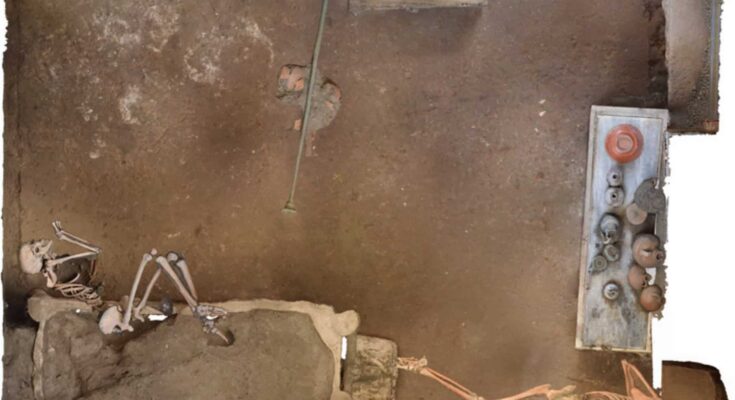Recent archaeological excavations in Pompeii have uncovered the skeletal remains of two people—a man and a woman—who died during the eruption of Mount Vesuvius in 79 CE.
The bones were discovered in a small room within a house. The room measured about 2.8 by 3.5 meters (9 by 11.5 feet). The woman’s skeleton was found on what used to be a bed. In her vicinity, researchers found a collection of gold, silver, and bronze coins, along with jewelry.
Among the jewelry were gold and pearl earrings. A key was also found near her, hinting that she might have been trying to gather her valuables in the last moments of her life, as reported by Archaeology Mag.
The man’s remains were detected in a different corner of the room near what seems to have been an exit. He was estimated to be between 15 and 20 years old. It appears he was crushed by a collapsing wall, leaving him trapped in a small, confined space.
Seeking shelter in the bedroom
Experts suggest that the pair sought safety in this small room, probably a bedroom, as the volcanic ash and debris continued to fall. The room, separated from the rest of the house, provided some protection from the pumice stones that filled the nearby grand hall.
However, this separation also became a fatal trap. When the hot gas, lava, and ash surged through the city, the victims had no way out.
Gabriel Zuchtriegel, the director of the Pompeii Archaeological Park, explained that even after two thousand years, we can still feel the pain and sadness of the people who died. He added that their work is not just about studying history, but also about understanding the human suffering that took place in Pompeii.
The discovery is part of a larger project focused on protecting and preserving the excavation areas at Pompeii, which has become a major tourist destination in Italy.
Excavating the fragile skeletons of the two Vesuvius victims
Using specialized techniques to recover the fragile skeletons and objects found along with them, the experts poured plaster into the spaces left by decayed materials, allowing them to recreate the room’s furniture layout.
This included a bed, chest, chandelier, and marble-topped table that still had various utensils made of glass, bronze, and ceramics on it. These plaster casts helped archaeologists understand where the items were originally located during the eruption, according to Archaeology Mag.
Pompeii, a lively resort town located south of what is now Naples, was home to between 10,000 and 20,000 residents when Mount Vesuvius erupted. It is believed that about 2,000 of these people lost their lives within just 20 minutes of being hit by the pyroclastic flows.



